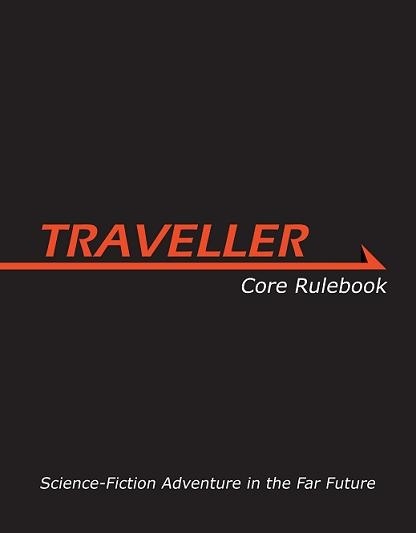This post is the first in a series dedicated to role-playing games. Old-school role-playing games. Back when you had to, yanno, use pens and pencils. And dice.
I know better than to start with Dungeons and Dragons. We need to work our way there in easy stages….
So why not kick things off with Traveller? Its 1977 publication established Marc Miller’s Game Designers’ Workshop as a force that even TSR would have to reckon with, particularly as the game quickly outgunned TSR’s own science fiction contender, Gamma World. Turns out that swashbuckling space opera resonated more than a scenario in which Earth had been microwaved and a bunch of mutants were left to fight over the scraps. One can speculate that perhaps in the Cold War throes of the 1970s/1980s, post-apocalyptic environments seemed a little too real. A dose of healthy escapism was in order.
And Traveller was made to fit the bill (we’ll get to Gamma World later). The essence of a particular strand of science fiction is a bunch of guys cruising around the galaxy on a beat-up spaceship, and that’s what you got with Traveller, as GDW happily cranked out adventure after adventure within that basic framework. Miller’s team also worked to release various supplemental booklets that expanded the rules to include mercenaries, merchants, planets, and fleet battles of various sizes. In doing so, they were drawing on the incredibly rich world they’d created, with a robust timeline and— perhaps even more importantly—ultra-cool maps.
Speaking of, let’s take a look at the overall one: http://www.travellermap.com/
Ah, the Traveller version of the World of Greyhawk. I used to spend hours gazing at it, imagining the journeys between the stars . . . the strange planets . . . the weird aliens. And this map goes one better than the original, as you can zoom in on various sectors (via the controls in the upper right-hand corner). Like all good RPG creators, the Traveller brain trust was into serious detail….
They were also into a realistic sense of the vastness of space. This may look like a wide expanse of terrain—and indeed it is—but those map controls will show you what a tiny portion of the overall galaxy all that Traveller play was going down in. This isn’t a Foundation-style universe, where humanity spreads across the entire galaxy. Partially that’s because of the sheer size of the Milky Way, which was compounded by how Traveller envisioned jump-technology—you could only go star by star, guaranteeing the party all sorts of mad adventures along the way.
But the “narrow” expanse of play was also due to humanity finding itself hemmed in by several alien races. Which of course is where the Traveller universe really comes alive. The leonine Aslan, the doglike Vargr, the oh-so-buglike Hivers . . . . all of these were poised to give humanity (and PCs) a serious run for the money. Most of the adventures occurred in the fringe spaces between these various races, with the Spinward Marches being the classic default setting for any state of play.
Like any of the more succcessful old-school RPGs, Traveller went through all sorts of iterations, eventually being integrated into the GURPS format for a while. Purists can debate the merits of the various systems; for now, I’ll leave it at that and welcome suggestions about which RPG you folks want to hear me discuss in my next post.
David J. Williams is the author of the Autumn Rain trilogy (The Mirrored Heavens, The Burning Skies, and the forthcoming The Machinery of Light). More about the world of the early 22nd century at www.autumnrain2110.com.










